Maintaining good posture is tough. We sit a lot — at work, in the car, at the dinner table, while visiting with family and friends. Sitting is not a bad thing, but sitting incorrectly with slouched shoulders is. This position tends to happen frequently when we’re not paying attention to sitting up tall or neglecting to get up and move often.
Sitting incorrectly can lead to tightness in shoulder muscles and, eventually, pain in the surrounding joints (neck, shoulders, back and hips). In addition to slouching our shoulders, the amount of time we spend in a locked shoulder position (a lack of shoulder movement) also leads to issues. Think of all the time we spend carrying items, working at our desks, driving, texting or talking on the phone. There isn’t a lot of shoulder movement happening during these activities, and this lack of movement leads to general tightness and dysfunction. Luckily, there are strategies to combat all of this and promote good posture.
Your first plan of attack should be remembering to sit in good posture and to get up and move at least once per hour. This will help solve the majority of the issues. However, this may not be enough, so your next plan of attack should be to proactively stretch your shoulders.
Shoulders consist of many different muscle groups and areas. To help open up your shoulders and alleviate pain, use the six stretches below. We recommend doing at least one daily, holding for a minimum of 30 seconds (per side, if applicable). Relax by breathing slowly and controlled through each stretch.
- Back of Neck Stretch
Neck and shoulder muscles tend to go hand in hand. When we slouch our shoulders, we tend to push our heads forward, which can shorten or tighten the muscles on the back of our necks. A lot of these muscles also attach to the top of our shoulders. This stretch is a great way to lengthen and loosen the back of your neck muscles and send a nice stretch down your upper spine and back. Focus on looking straight down and tucking your chin into the back into the back of your throat while using your hands to pull your head slightly in that same direction. You should feel yourself get taller. Hold this stretch for 30 to 60 seconds.
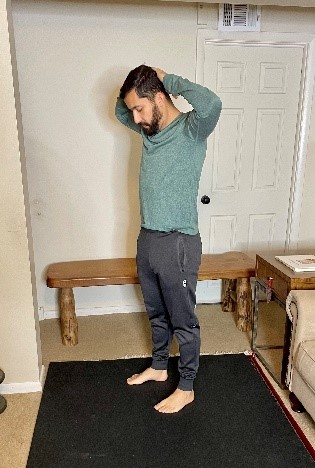
- Chest Corner
The chest is made up of a major group of muscles that attach to the front of the shoulders. This area gets very tight for a number of reasons, so we should stretch this area often. Bend your elbow and shoulder to a 90/90 position out to your side, and place your hand/forearm on the corner of a wall or doorframe. Lean forward, and slightly twist away from the wall, turning your head. Feel the stretch run from your shoulder down your chest and maybe even a bit in your neck. Hold for 30 to 60 seconds per side.
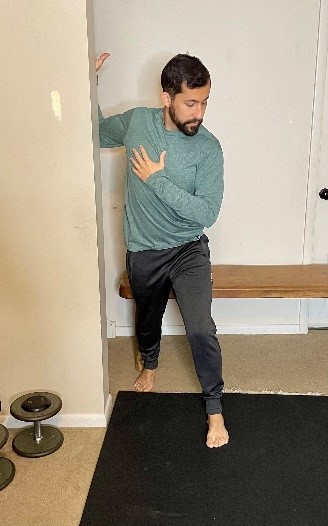
- Lat Wall Lean
The lat (or latissimus dorsi) muscle is a major muscle group that attaches to the top of the arm, wraps around the lower part of the shoulder and runs down our entire backs. Due to the location of this muscle, and the fact that we spend a lot of time with our shoulders in a locked position, this muscle gets tight from all the tension and lack of movement. For this stretch, take one arm straight against a wall with your thumb facing away. Lean slowly into the wall, and push your hips back. Feel the stretch move down the side of your shoulder and body. Hold for 30 to 60 seconds per side.
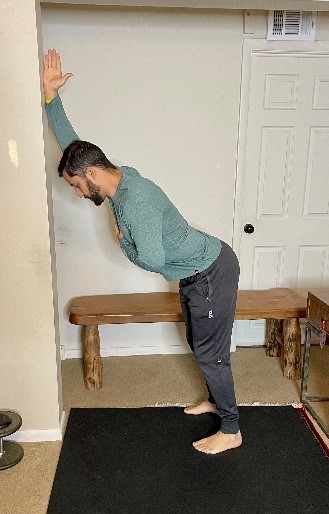
- Controlled Shoulder Windmill
This stretch takes the shoulder joint through full rotation, so it provides movement to all the muscles listed in the above stretches. The focus here is to keep your arm locked out, maintain tall posture with bending or twisting, and reaching your shoulder around through its fullest range of motion. Rotate your palm as you reach to help your shoulder rotate fully as well. Complete 3-5 reps per direction per side.
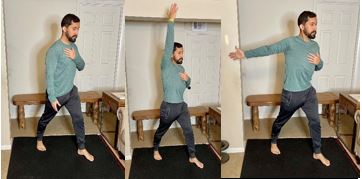
- Seated Chest/Biceps Stretch
Just like the chest gets tight, the biceps also get tight while doing similar activities, especially when carrying something or doing anything that requires our elbows to bend. This stretch helps to lengthen both the biceps and chest. Take a seat with your knees bent and hands on the floor straight behind you, palms facing back. Scoot your hips forward, and stick out your chest. Feel the stretch run from your shoulders to your elbows. Don’t go too far out, as this may hinder your ability to get out of the stretch. As an added bonus, push your hips up to a reverse table pose. Hold either variation for 30 to 60 seconds
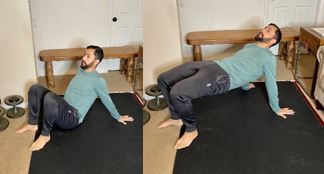
- Thumbs Up Child’s Pose
Similar to the Lat Wall Lean, this stretch mainly targets opening up the latissimus dorsi muscle on both sides. The stretch also hits other smaller muscles in your shoulder and helps to decompress the spine and pelvic area. Focus on keeping your arms straight and up in a Y position, with your thumbs up and head resting on the floor or another surface, and driving your chest toward the floor. Hold for 30 to 60 seconds (or longer).
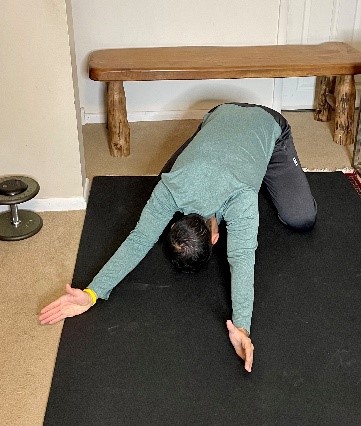
The shoulders are a group of many interconnected muscles. The more often we take care of them with lots of movement and a variety of stretches, the better off our shoulders (neck, back and hips) will be in the long run. Happy stretching!

